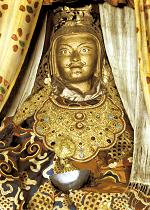Padmasambhava

Padmasambhava [Skt.], or Padmakara [Skt.] - Pemajungné [Tib.], the ‘Lotus-Born’, which refers to his birth from a lotus in the land of Oddiyana. Also known as Guru Rinpoche, the ‘Precious Master’, he is the founder of Tibetan Buddhism and the Buddha of our time. Whereas Buddha is known primarly for having taught the teachings of the sutra vehicle, Padmasambhava came into this world, and to Tibet in particular, in order to teach the tantras. While Buddha Shakyamuni exemplifies the buddha principle, the most important element in the sutrayana path, Padmasambhava personifies the guru principle, the heart of Vajrayana Buddhism, and he is therefore known as sangyé nyipa [Tib.], the ‘second Buddha’.
Biographies
There are many accounts of Guru Rinpoche’s life, written by great scholars or revealed by the tertöns. Some of the most famous of his biographies are the Namthar Zanglingma, ‘The Zanglingma Lifestory’, named after the Copper Temple at Samyé where it was discovered as a terma by Nyangrel Nyima Özer, the Padmé Kathang or Namthar Sheldrakma, ‘The Life-Story from the Crystal Cave’, revealed by Orgyen Lingpa, the Kathang Serthreng ‘Golden Garland Chronicles’ discovered by Sangyé Lingpa, and the Namthar Yikyi Münsel, ‘The Life-Story that Dispels Mind’s Darkness’, by Sokdokpa Lodrö Gyaltsen. Guru Rinpoche’s life is also recorded in the histories of the different teaching cycles; there exists a famous Indian version compiled by Jetsün Taranatha, and biographies are even to be found in the Bön tradition of Tibet.
- See ‘The Life of Guru Padmasambhava’ in A Great Treasure of Blessings.